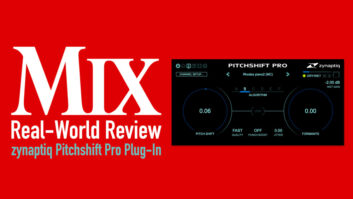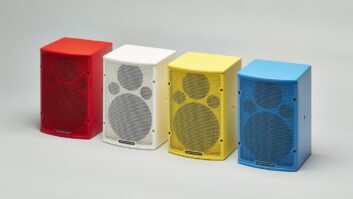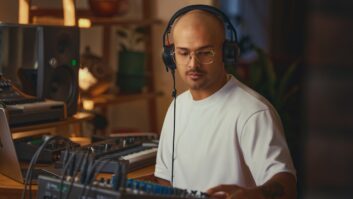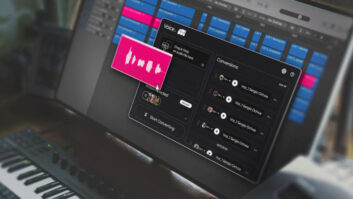Dolly Parton’s flamboyant, exaggerated, country girl-meets-Hollywoodlook is one of the most identifiable in American culture. Aless-talented or savvy artist might not have been able to get away withsuch an audacious visual statement, but Parton is so talented as asinger and a songwriter that there’s no question that her true giftsshine through.
Our interview was held in a small house at Parton’s walledSouthwestern-style office complex in midtown Nashville. When I was ledthrough the courtyard and into the dwelling, the first space I enteredwas a well-lit, mirrored dressing and make-up room adjacent to a homeyliving area and kitchen.
Almost immediately, Parton entered the room lookinglike…Dolly! She seemed to glow, yet she was very accommodatingand down-to-Earth; in fact, she offered to fix me breakfast. I didn’tdoubt the sincerity of her offer, but I didn’t exactly want to put herto work.
At the time of the interview, Parton was excited about her newlycompleted album for the Sugar Hill label, Halos and Horns, whichshe eagerly previewed for me on a jam box. It features a new band shecalls The Blue-niques (for “unique bluegrass”); membersinclude Steve Turner, Kent Wells, Jimmy Mattingly, Richard Dennison,Gary “Biscuit” Davis, Brent Truitt, Jay Weaver and RandyKohrs.
Fans of her last two bluegrass and roots music albums (also on SugarHill) will probably love this collection, too. It contains more ofParton’s fine original compositions, as well as two classics, which, asParton puts it, she “Dolly-ized”: Bread’s “If”and, believe it or not, Led Zeppelin’s “Stairway toHeaven.”
Hello.
Do you want some breakfast? I can make you some toast and eggs ifyou need it.
I appreciate it, but this is just fine (rummaging through candyin the coffee table bowl).
Are you sure? I’m happy to do it.
You don’t need to do that, but thanks. Snickers and Milky Way:This is a fine starter for the day.
Like typical studio people, you’re eating candy right away. [Laughs]Eat junk. You can do like we all do in the studio — just throwthe wrappers on the table. Don’t worry, I’ll get rid of it later. Now,you can eat all the candy you want.
Unlike the last two albums, the majority of this new albumfeatures original compositions. Many of those seem to have a spiritualundercurrent. The title track is really strong.
I wrote several songs after September 11, like we all did. Thatevent really just shook everybody’s confidence: You saw how fragilelife is and how small and fearful we all are. You just realize thatthere must be something greater than you; otherwise, you’d totally fallapart. You think you can just screw around all you want to until youget in trouble, and then the first thing you say is, “Oh God,help me now.” It’s sort of like a child getting hurt.
I just felt real inspired, and this idea started rolling out and Iwrote “Halos and Horns” in no time. I have very strongfeelings about that song. It’s a real solid country, bluegrass thing— one of those hard-singing songs. I really like it.
This album is really just life stories. It goes from heartache toheaven. There are some gospel things — like “HelloGod” — to one that is talking about swimming naked in apond. [Laughs] Spirituality to sexuality.
You could say that it’s all part of the big picture.
Yeah, well, it’s true. That’s how I look at life.
When I first heard that you were going to do “Stairway toHeaven,” I thought that was an audacious choice. But when I sangthrough the melody in my head before I came here, I could hear yousinging it.
I love that song, and I always thought it sounded like a spiritualsong. Robert Plant said he had always thought of it as a spiritual songand was thrilled that I had put the choir on it, ’cause he had alwaysheard it like that. I believe a good song can be done any way if youreally mean it from the heart.
Everybody’s been trying to get a copy of my version of this song.They’ve been offering everybody money to bootleg it. Rock stations havebeen calling us, and country stations just out of curiosity. I’m suresome of them think it’s a big joke. I’m sure that some of them aregoing to want to crucify me, and maybe they will. But in all sincerity,I did it because I love the song.
I take this stuff so seriously. These things are sacred to me. WhenI decided I was going to do “Stairway to Heaven,” I trulyfelt like I was walking on sacred ground. It’s the same with a songlike “If.” When you get a great song that’s a classicthat’s touched the lives of so many people, you have to handle it withdelicate care. You just don’t go in and put anything on it. You look atit like, “What can I do with this great song that is a littledifferent and will still not be a gimmick, but to make it myown?”
I remember all the quality songs through the years that I’ve heard,and I just loved David Gates’ stuff and the group Bread. I did“If” up-tempo — sort of like what Ray Stevens didwith “Misty.” It kind of reminds me of the song“Everybody’s Talkin’.” It’s kind of got that rolling thing,and I think it worked.
A defining quality that seems to push your career and personaalong is fearlessness.
You’re right. What have I got to lose? If you don’t take somechances, what are you going to do that’s of any quality? I’ve made alot of mistakes in the minds of some people, but I’ve made few, if any,in my own mind. If I make five mistakes and do one great thing, well,I’m not going to worry about the five mistakes I made. I’m going tojust wallow in the glory of the one great thing I did in hopes that itbrought some joy to somebody else. What some would call a mistake isjust me trying. If it works, fine. If it don’t, what are they going todo? Kill me? Then, if they kill me, are they going to eat me?! [Laughs]You can’t really go about your life like that and be productive. That’swhy I think I’ve been at it for so long.
I’m up there. I’m 56 years old, and I’ve been doing thissince I was a little kid. I started writing serious songs when I wasseven. I started singing on TV when I was 10. I was just a littlebackwoods country kid that had a more outgoing personality than some ofthe other backwoods kids. I was still nervous, but my desire to dothings was always greater than my fear of it. I just always kind ofdrug from that God thing. My grandpa was a preacher, and I guess at animpressionable age, I believed that through God I could do everything.And I still have a lot of faith in God, as I perceive him, and that’swhy so many of my songs have an inspirational feeling.
Everybody thinks of God as a different thing. To me, God is thatgreater, higher energy — that greater, wiser wisdom. It’s thatthing in all of us that we all have to draw from. I’ve always trustedGod and trusted myself, which to me are intertwined. I’m a creativeperson, and what gifts I have come from that divine place that I try totap into. So who have I got to be afraid of?
How did this new album evolve?
This album all started because I was really just trying to find aband. I’d been writing songs for several months, and I went to eastTennessee to try to find as many musicians back home as I could for aband. A lot of these people work at Dollywood [Parton’s successfulamusement park]. Gary Davis, who helped me pull all of this together,put the band together. I thought, “I’m just going to go in anddemo these songs through my publishing company and pay for this andfind a good studio up home. I’ll bring these musicians in to play onthe demo; that way, I can feel them out.” Well, when we got inthere, they just all sounded great from the start.
I was looking for a good studio in the area where I could stay up inmy old Tennessee mountain home and write. Then, Gary Davis told meabout a really great studio called Southern Sound Studio outside ofKnoxville. Danny Brown, who was the engineer for this, is one of thepartners of the studio. They do a lot of important stuff there. So, Idecided to go ahead and do a whole bunch of songs there; we did 25songs over the course of several weeks.
You self-produced this effort, and it sounds like you haveanother album in the can.
Yeah, if I want to do that. I don’t know what I’ll do next. I alwaysjust let the spirit lead me. But, definitely, there’s enough stuff foranother album at some point.
When we started doing this, I told Steve Buckingham, who’s my friendand has worked with me as my producer and co-producer for 12 or 13years — he also runs the label and everything — “Thisstuff is turning out really good. It sounds like it could be arecord.” Steve said, “Well, just go on with it. Just letwhat happens happen.” So I did. I missed working with Steve onit, but he’s been really behind me all the way with this project. I wasso excited about my new band because I haven’t had a band together in10 years. We’re going to be doing some concerts in July and August.We’re going to go out and promote this, and if it feels good, then I’mgoing to do some touring.
You didn’t tour behind your previous two albums?
No. We never could pull it together to where we could tour. Jerry[Douglas, dobro player] is with Alison [Krauss], and they are allcommitted to other projects. It was driving Steve crazy trying to pulla band together, so he is thrilled to death that I’ve got a bandnow.
Dollywood is one of the most successful theme parks in thecountry. What inspired that project?
Well, a business mind and the whole idea that the Smoky Mountains isthe most visited national park in the United States. We got almost 3million people last year, and we’re only open six full months [a year].It came from me just wanting to do something to make my people proud ofme, and it’s also really provided a lot of jobs for the area. It’shelped a lot of people, and it’s helped me, too. I just thought itwould be great to have something to leave for my family.
I found it interesting that Dollywood’s ad campaign was focusedon a world music theme. You came from the mountains of east Tennesseebut you’ve seen the world, and I was struck with a sense that you werebringing the world into the place you were raised.
That’s exactly right. It’s a wonderful thing, and people haveresponded so much to that. That’s my home, I suppose, in that it’swhere I was born and raised, and I love the mountains and that’s myfoundation. But my home is everywhere. I often joke that home isanywhere I hang my hair. It’s true. Whether it’s Russia or here, I lovepeople. I just feel like I am part of everything. I am part of thatbigger picture.
I perform there several times a year, including benefit shows forthe Dollywood Foundation. We have a huge thing that the United Way isin on now called the Imagination Library. For years now, we’ve givenscholarships to people with medical and school needs, and we still do.We even have a hotline for kids. Every child that’s born in SevierCounty [where Dollywood is located] gets a book a month from the daythe child is born until the day it starts kindergarten. We’ve given outthousands of books now all over, and it’s really growing. They call methe Book Lady. It’s a wonderful thing, because my dad couldn’t read orwrite, and so many of my relatives didn’t get an education, and it wasimportant for me to do that. So, not only is Dollywood a theme park, itreally does a lot of good things, and a lot of good stuff comes out ofthat.
Now, I’m having to speak to all these educators and teachers, and Ihated school growing up. I’ve done more homework in the last five yearsjust working on these projects than I did in 12 years [in school].
Somebody said, “Well, now that you’re the book lady and you’reinvolved with these kids and this education, are you going to tone downyour look?” And I said, “Why should I? It was all of thatthat made all of this that put me in this position! Don’t you get it? Imight look like a phony now, but if I start changing things, then Iwould be a phony. This is who I really am. I see no reason tothink that I have to look like a schoolteacher. I’d rather look like awhore. I’m getting the job done, it shouldn’t matter.” You know,people are funny about changing.
It’s like a version of “Harper Valley PTA.”
That’s true. A lot of my look came out of a little country girl’sidea of what glamour should be. But then it got to be reallycomfortable, and I liked it — just like how people like to dressup. I’ve always said that if I hadn’t have been a woman, then I’d havedamn sure been a drag queen. That might be a funny line and people geta kick out of it, but I mean that in all sincerity. I just love it.
People say, “Do you wear those shoes around all the time? Doyou wear that makeup all the time?” I say, “Yeah, I do mostof this even when I’m by myself.” I can’t stand to walk aroundslouchy all day. When I’m alone writing songs, sometimes I’ll go for acouple of days and I won’t put on makeup and stuff, but I don’t look atmyself. Sometimes, I look in the mirror and I’ll say, “Oh goodLord, go clean up!” Everybody’s comfort level is their own.
Thank God that early on I understood who I was. I understood thatbeing from a family of 12, I was in a spot where nobody was going topay that much attention to me, so I had to get to know myself throughGod and through the birds and the bees and the stuff outside and myimagination. Thank God I had talent. But most of my family had talent.I took it and channeled it, and the better I got, the more I wanted todo good, and the more I realized that this is important stuff.
When I get one of those songs that’s got all that heart and guts andsoul and tears — whether it’s a happy song or not — that acertain kind of song and my soul just dance. It’s in that real place,and as long as it comes from my gut and from my heart in a very realplace, I think people will accept it.
I’m proud of Dollywood and all the business stuff that I’ve been atleast smart enough to be wise to, where I could make my money doingother things. But, to me, all that other stuff just affords my habit,which is music. First and foremost, above everything else, I’m asinger, a musician and a writer. I never got so busy I didn’t writesongs. I write all the time, and I love it. I pay for my own sessions,then I lease them to whatever label, and then my masters go back to me.After a certain amount of time, I’ll want my masters throughout theyears to go to my family. That’s the way I’m doing it. But I’d besinging if I had to sell it out of the trunk of my car. I will be doingmy singing and my writing no matter what.
Mix’s Nashville editor Rick Clark is also the producer of theaward-winning Oxford American music CD collections.
ENGINEERING “HALOS AND HORNS”
When Dolly Parton began looking for a place to record Halos andHorns, her production assistant, Gary “Biscuit” Davis,brought her to Southern Sound Studio, a multiroom recording andmastering facility located in Knoxville, Tenn. The StephenDurr-designed studio, which is near Parton’s east Tennessee retreat andless than an hour away from the Smoky Mountains, has been at itscurrent location since 1994. That year, it was recognized by Mixas one of the best-designed new facilities in the country. It is ownedby Danny Brown (who engineered and mixed the project) and PaulJones.
When Brown began working with Parton’s voice, he initially workedwith a Neumann M149, and his mic pre of choice was a Drawmer 1969.“The Drawmer 1969 seemed to sound the best with Dolly’s vocal andthe M149,” says Brown. “Though the M149 is veryEQ-friendly, we found we had to add quite a bit of 5k to 12k to get thepresence Dolly was looking for. We then brought in a Sony C-800G, andthe results were fantastic. Her voice translated so well through thismic with no EQ at all.” The Avalon VT-737 became the mic pre ofchoice for the Sony mic and Parton’s voice.
“One of the great aspects of the Sony is that it has little tono off-axis coloration, even in the cardioid position. Every time Dollystepped up to the mic, she delivered a vocal performance; every song,every vocal track,” Brown adds. “She is a very emotionalsinger. Her mouth never stayed right in front of the mic. The Sony wasvery forgiving and seemed to capture every detail of her voice, nomatter where her head was turned. We were all very pleased with the endresult.”
A new Universal Audio LA-2A was used on her vocals during the mix.Parton’s vocals were tracked without EQ and just about 1 to 2 dB ofcompression from the Avalon VT-737. During the mix, the LA-2A was usedwith a bit of EQ from the VT-737, mostly just to add a little more airto her sound.
“We did some vocal comping, but that became difficult attimes. What I mean is, which line do you pick? Which verse do you gofor when they all sound so incredible?” Brown says with a laugh,who did the comps with Richard Dennison and Davis. “We foundourselves basically comping for what we thought would best suit Dolly,because every take was excellent.”
Everything was recorded on the iZ Technology RADAR 24. Brown mixedon a DDA Profile 56-input console with Uptown moving fader automation.The mix was monitored on Dynaudio M-1 near-fields.
“We ran the mix bus through a Waves L2 into an AlesisMasterlink at 24-bit, 44.1,” Brown says. “It then went toSoundcurrent Mastering, which is based at our facility, to be masteredby Seva. Nuendo was used to do some editing. The main monitors fortracking were custom TADs, powered by Crown Macro reference amps.
” Rick Clark





